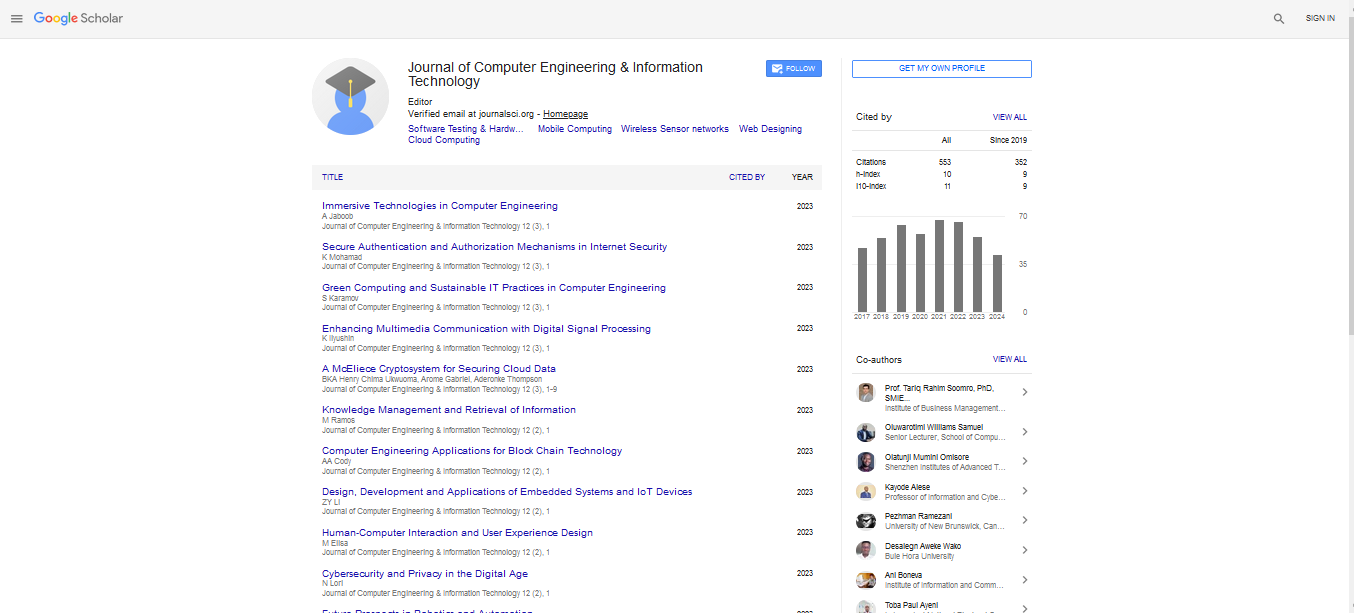Opinion Article, J Comput Eng Inf Technol Vol: 13 Issue: 5
The Role of Artificial Intelligence in Detecting and Preventing Cyber Attacks
Ola Ben*
1Department of Artificial Intelligence, University of Bristol, Bristol, UK
*Corresponding Author: Ola Ben,
Department of Artificial Intelligence, University
of Bristol, Bristol, UK
E-mail: ola.ben34@uob.edu.br
Received date: 13 August, 2024, Manuscript No. JCEIT-24-146805;
Editor assigned date: 16 August, 2024, Pre QC No. JCEIT-24-146805 (PQ);
Reviewed date: 30 August, 2024, QC No. JCEIT-24-146805;
Revised date: 06 September, 2024, Manuscript No. JCEIT-24-146805 (R);
Published date: 13 September, 2024, DOI: 10.4172/2324-9307.1000309
Citation: Ben O (2024) The Role of Artificial Intelligence in Detecting and Preventing Cyber Attacks. J Comput Eng Inf Technol 13:5.
Description
Artificial Intelligence (AI) is revolutionizing the field of cybersecurity by providing advanced tools and techniques to detect and prevent cyber-attacks. As cyber threats become more sophisticated, traditional security measures are often inadequate to address the complexity and scale of these threats. AI, with its ability to analyze vast amounts of data and identify patterns, offers new avenues for enhancing cybersecurity defenses. This discuss the role of AI in detecting and preventing cyber-attacks, highlighting its applications, benefits, challenges and future prospects. Cyber threats have evolved from simple, isolated attacks to complex, multi-faceted campaigns targeting various aspects of digital infrastructure. Threats such as ransomware, phishing, Advanced Persistent Threats (APTs) and zeroday exploits require advanced detection and response capabilities. Traditional security methods, including signature-based detection and manual monitoring, often fall short in identifying and justifying these sophisticated attacks.
AI offers a promising solution by providing real-time analysis, predictive capabilities and adaptive defenses. AI systems use machine learning algorithms to establish a baseline of normal network behavior. By continuously monitoring network traffic, these systems can identify deviations from the norm, which may indicate potential threats. Anomaly detection is particularly useful in identifying previously unknown attack patterns and zero-day exploits. AIpowered tools analyze user and entity behavior to detect suspicious activities. By establishing behavioral profiles for users and devices, AI can identify deviations that may signal compromised accounts or insider threats. This approach helps in detecting subtle indicators of malicious activity that traditional methods might miss. AI systems can aggregate and analyze threat intelligence from various sources, including threat feeds, security logs and social media. This aggregated data helps in identifying emerging threats and understanding attack patterns. AI can correlate data from disparate sources to provide a comprehensive view of the threat landscape.
AI can automate incident response processes, reducing the time required to detect and respond to threats. Automated response systems can execute predefined actions, such as isolating affected systems, blocking malicious traffic, or applying patches. This rapid response helps minimize the impact of attacks and reduces the workload on security teams. AI systems can adapt to new threats by continuously learning from new data and attack vectors. Machine learning algorithms can update their models based on the latest threat intelligence, allowing security systems to evolve and respond to emerging threats. This adaptability is key in keeping up with the fastpaced nature of cyber threats. Predictive analytics powered by AI can forecast potential security incidents based on historical data and emerging trends. By analyzing patterns and identifying potential vulnerabilities, AI can help organizations anticipate and prepare for future attacks. Predictive models provide valuable insights into potential threat scenarios and enable proactive measures.
AI enhances Security Information and Event Management (SIEM) systems by providing advanced analytics and correlation capabilities. AI-powered SIEM systems can sift through vast amounts of data, identify correlations between events and generate actionable insights. This improves the efficiency of threat detection and reduces the time required for investigation. AI can assist in automated threat hunting by continuously scanning for Indicators of Compromise (IoCs) and unusual patterns. Threat hunting tools powered by AI can proactively search for signs of malicious activity, reducing the reliance on manual analysis and improving the overall effectiveness of security operations. AI algorithms can analyze email content, URLs and attachments to detect phishing attempts. Natural Language Processing (NLP) techniques enable AI to understand the context and intent of messages, identifying potential phishing threats with greater accuracy.
AI-driven phishing detection systems can provide real-time alerts and prevent users from falling victim to phishing scams. Artificial Intelligence is transforming the field of cybersecurity by offering advanced tools and techniques for detecting and preventing cyberattacks. Through applications such as anomaly detection, behavioral analysis, automated response and predictive analytics, AI enhances the accuracy, efficiency and scalability of security measures. While challenges such as data privacy, adversarial attacksand integration issues remain, the benefits of AI in cybersecurity are substantial. As technology continues to evolve, AI will play an increasingly lifethreatening role in defending against the ever-changing landscape of cyber threats. By including AI’s capabilities and addressing its challenges, organizations can better protect their digital assets and maintain a secure environment in a rapidly advancing technological world.
 Spanish
Spanish  Chinese
Chinese  Russian
Russian  German
German  French
French  Japanese
Japanese  Portuguese
Portuguese  Hindi
Hindi 